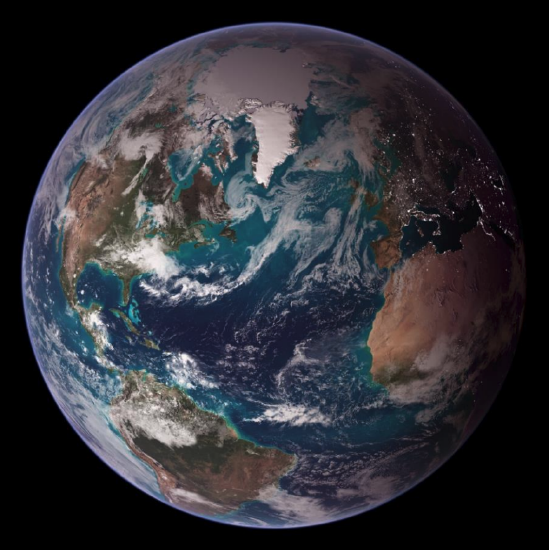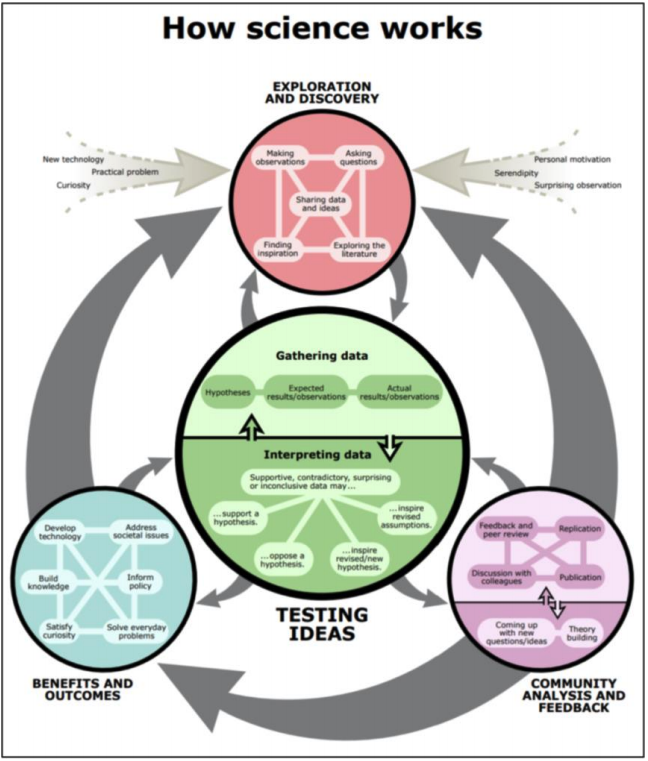1.1: Front Matter
- Page ID
- 14765
Thumbnail for Chapter 1:

Thumbnail: “Western hemisphere” (Public Domain; Reto Stöckli for NASA)
What Is Science?
Science is not just a subject: it’s a way of thinking. Science is the process used to objectively investigate the universe and everything in it. Geoscience, including geology, offers an important perspective for understanding our world! As geoscientists, we study the Earth of the past, present, and, sometimes, the future.
In previous classes, you may have encountered the scientific method; however, it is worthwhile to review as it is foundational to any science course. The first stage of the scientific method is observation. An observation requires using the five senses to engage with the world around you. Observations may be simple, like identifying the outward color of a mineral. Sometimes, however, observations will require you to learn basic background information through an experiment or test. For example, testing the streak of a mineral will require you to rub the mineral across a porcelain plate. This can produce a colored powder that can then be recorded. It is important to always document observations. Many geoscientists record their observations in a field notebook or on a computer. Documentation ensures records can be accessed in the future, and methods can be duplicated by others. Oftentimes, your observations will lead to questions. In fact, you may find yourself with many questions; this is okay! You may even find yourself repeating the observation portion of the scientific method many times in order to feel confident to move forward in the process. This is also okay, because your continued investigation keeps the process of science alive.

The questions generated during the observation stage can be constructed into a hypothesis. A hypothesis is a testable prediction of how something works. A hypothesis should be framed in such a way that it is easy to test. Science works to rigorously disprove a hypothesis. Only hypotheses that withstand the rigor of testing become accepted. Regardless of whether a hypothesis is verified or rejected, new information will be gained. When a hypothesis is rejected, this does not equate to failure of the experiment. Instead, it is a prompt to revisit the original observations, make new ones, ask new questions, and form new hypotheses to test.
The final stage of the scientific method is communication. This stage is often skipped in traditional discussions of the scientific method, but it is very important, and, with the advent of the internet and social media, has become considerably easier to accomplish. Communication within the scientific community allows for experiments to be replicated in novel ways, expanding the original hypothesis and addressing questions from many perspectives. This is why a diverse scientific community is so important! Our “Scientist Spotlights” highlight diverse Geoscientists from their respective fields; we hope you enjoy each short biography.
In addition to communication within the scientific community, communication with the general public is also important. This can be done through a press conference, news report, written article, or via social media, blogging or vlogging. Many scientists have taken to social media, which has encouraged a rapid, global exchange of information. Check out #ScienceTwitter, #SciComm, and #ScienceComm for a wealth of science information. As with everything on the internet, be cautious and critically evaluate your sources. Be open to new information and willing to adapt and change your mind when confronted with data, evidence, and facts. If you have an interest in science and journalism, many institutions now offer science communication or science journalism degrees at all levels.
During an individual scientist’s career, they will often only participate in a small portion of the scientific method. Hundreds of related observations and tested hypotheses accumulate for scientists to formulate a theory. A scientific theory is an explanation for a natural phenomenon that is supported by a wealth of scientific data. A theory is not yet a scientific law if there is still some debate on the exact workings of the theory or the reasons why a phenomenon occurs.
What Are the Geosciences?
Earth is a complex and dynamic place, with many moving components and processes. Geoscience (Earth Science) examines the Earth: a considerably massive subject. Take a minute to think about everything you encounter every day that is connected with Earth. Is your mind blown yet? Welcome to the career of a geoscientist! A geoscientist is someone who studies the Earth System. Geoscientists have varied and diverse careers. Many are employed by universities where they teach and/or do research, and state and federal agencies, including geological surveys, like the California Geological Survey or United State Geological Survey (USGS). Additional career pathways include environmental policy, legislation and consulting, or science communication via the private sector or state and federal agencies. Many of these career options require a college degree and postgraduate work. If you are interested in the geosciences, talk with your geology instructor for advice.

The broad range of subjects within geoscience are frequently multidisciplinary, involving crossover with many other fields including STEM (Science, Technology, Engineering and Mathematics), Social Sciences, and the Arts. A geoscientist typically solves problems using an interdisciplinary approach. This requires them to work with and learn from many fields to address diverse questions. For example, a paleoclimatologist, a scientist who studies climates of the past, searches for information about past climate through ice or sediment cores, fossils, and rocks. The information they collect can be used to understand climate through past geologic time but also current and future climate change. Their research can be utilized for hazard mitigation, planning, and preparation at the city, county, state, and federal levels.
Because of the interdisciplinary nature of the geosciences, we recommend completing as many math and science courses as possible. Also, visit National Parks, CA State Parks, museums, gem & mineral shows, or join a local rock and mineral club. Typically, natural history museums will have wonderful displays of rocks, including those from your local region. Here in California, there are a number of large collections, including the San Diego Natural History Museum, Natural History Museum of Los Angeles County, Santa Barbara Museum of Natural History, and Kimball Natural History Museum. Many colleges and universities also have their own collections/museums.
Within the geosciences, there is the discipline geology, the scientific study of the Earth. In general, geology has two major branches of study: 1) Physical Geology, which focuses primarily on what the Earth is composed of and how its processes work beneath and at the surface, and 2) Historical Geology, which examines the evolution of Earth through geologic time. There are aspects of geology that are directly testable and others that cannot be directly tested. Geologists must use their imagination to discover aspects about the Earth and its history that we cannot directly observe.
Within this physical geology laboratory manual, we will focus on materials that make up the Earth, like minerals and rocks, and Earth processes, including plate tectonics, weathering and erosion, and many others. The topics covered in this manual are varied and well-suited for an introductory level community college course. We hope that you enjoy the topics and become more curious about the world around you!
Attributions
- Figure 1.1: Understanding Science: How Science Works. ©University of California Museum of Paleontology. Used with permission (13 November 2020). [All rights reserved].
- Figure 1.2: “Quick Facts: Geoscientists” (Public Domain; US Bureau of Labor Statistics)
- Figure 1.3: “Western hemisphere” (Public Domain; Reto Stöckli for NASA)


